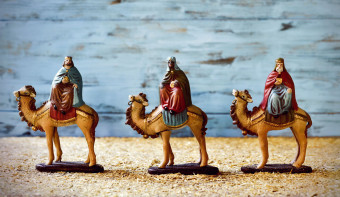About Palm Sunday
When is Palm Sunday?
Palm Sunday is a Christian moveable feast that falls on the Sunday before Easter. It falls on a Sunday between March 15th and April 18th.
Palm Sunday is the first day of Holy Week, a period leading up to Easter. Holy Week is the last week of lent, before the festival of Easter and the end of fasting. The Holy Week is seven days of religious significance, with masses often held on key days.
Why is it called Palm Sunday?
During the Jewish Passover celebration, Jesus rode into Jerusalem and was given a hero’s welcome by the people, who had heard of his miracles and regarded him as the leader who would deliver them from the domination of the Roman Empire. They carried palm branches, a traditional symbol of victory, and spread them in the streets before him, shouting ‘‘Hosanna, glory to God’’ (John 12:12,13). Jesus' triumphal entry into Jerusalem is mentioned in each of the four canonical Gospels.
Palms are still used in church services on this day, which is the beginning of Holy Week, and Jesus’ triumphal entry into Jerusalem is often reenacted with a procession—the most impressive being the one in Rome, where the pope, carried in St.Peter’s Chair, blesses the palms.
At the beginning or end of the service, the palms are distributed to the congregation. In some countries, where palms are not available, branches of other trees—particularly pussy willow, olive, box, yew, and spruce—are used. They are later hung up in houses for good luck, buried to preserve crops, or used to decorate graves. The palms may be burnt and used as the ash for the following Ash Wednesday.
On Holy Thursday - also known as Maundy Thursday - Jesus was arrested after the Last Supper, before being crucified on Good Friday.
According to the bible, Jesus then rose again on Easter Sunday.
This day may also be known as Passion Sunday, Carling Sunday, Willow Sunday, Branch Sunday, Blossom Sunday or Fig Sunday.
Palm Sunday Traditions
Fig Sunday
The custom of eating figs on Palm Sunday gave rise to the name Fig Sunday, or Fig Pudding Day, in England, when children would buy figs and either eat them or bring them home to their mothers to make fig pudding. The name may have come from Jesus’ cursing of the barren fig tree on the day after his entry into Jerusalem, as told in the 11th chapter of the Gospel of Mark.
Austria
Many Austrians go to church today to have their palm bushes (palmbuschen) blessed. Palm bushes often consist among other things of hazelnut branches and catkins decorated with colorful ribbons. These are brought to the church in the morning where they are blessed. Churchgoers then return home to leave the blessed palm bush at the entrance of the house or in the garden.
Germany
In Bavaria, branches from 12 different kinds of wood are cut, then bent and fastened to long poles in a semicircular shape and decorated with glass beads to resemble glittering trees. The trees are carried in procession to the church, blessed by the priest, and then set up in the farmers’ fields to protect the crops and ensure a bountiful harvest.
Italy
On Palm Sunday the piazzas in front of most small Italian churches are filled with people dressed in spring clothes and vendors selling olive and palm branches. The olive branches are often gilded or painted silver, and the palms are braided into crosses and decorated with roses, lilies, or other flowers.
After the palms have been blessed in the church, they are often exchanged as a peace offering or sign of reconciliation between those who have quarreled. In Rapallo, a center for the silk industry, silkworms’ eggs are taken to church on Palm Sunday to be blessed.
Similar Observances
Feast of St Basil
Read More










